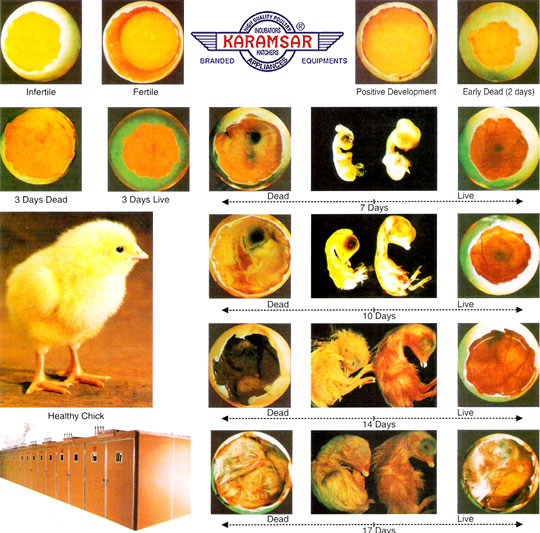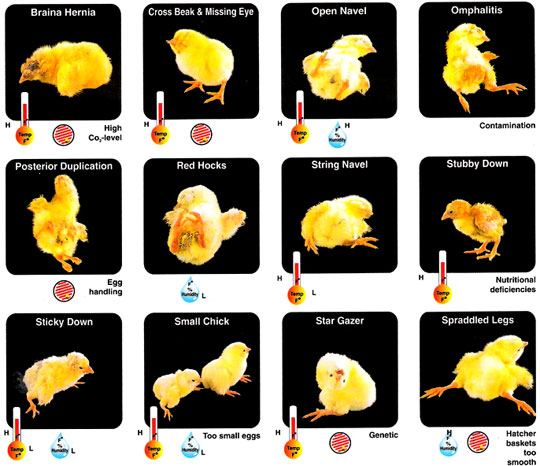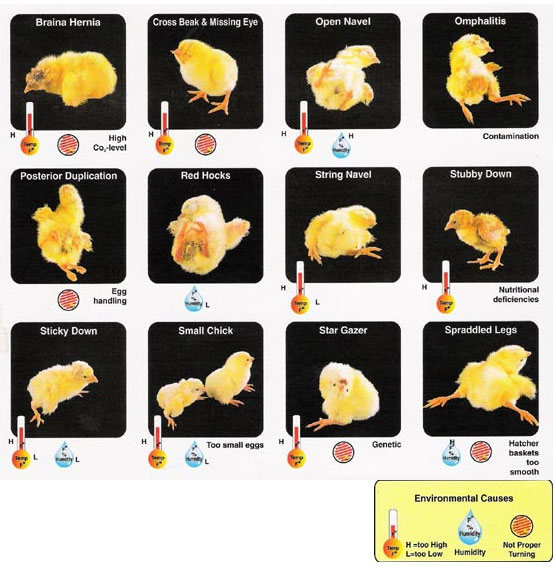



Careful Culling and flock Selection for high hatchaability.
Raise males together. Use 4 to 7 males per 100 females with light breed chickens,
5 to 8 males per 100 females with heavy breeds. 8 to 13 males per 100 females for turkeys.
Do not use old males, unless proved valuable breeders.
Use properly balanced feed of high quality. Provide adequate waterers of good design well distributed, so that, all birds can have easy access to fresh water.
Provide adequate floor space per bird in housing.
Use early hatched cockerettes timed for best maturity.
Dub males to prevent this problem, and also improve fertility.
Carry out approved disease control practice.
Gather eggs often, cool properly and quickly.
Proper conditions for egg holding be observed.
Gather eggs often. Coo! properly and quickly. Refer instructions for egg holding.
Check accuracy of thermometers, Operate incubator at proper temperature.
Refer instructions regarding fumigation of eggs in the incubator.
Do not set eggs from birds with frozen combs or from diseased birds, particularly those infected with pullorum or other salmocilla diseases.
Feed properly balanced ration of high quality.
Careful culling and flock selection for high hatchability, improve breeding for high hatchability.
Check accuracy of thermometers. Operate incubator at proper temperature.
Provide adequate ventilation of the incubator at and proper openings of the Incubator rota vents.
Turn eggs at regular intervals.
Maintain proper humidity levels throughout incubation and hatching cycle.
Maintain proper humidity levels throughout incubation & hatching cycle.
Provide adequate ventilated room & proper openings of rota vents of machine.
Maintain proper temperature throughout incubating & hatching cycle.
Use proper operating temperature.
Maintain proper humidity levels throughout incubation and hatching cycle.
Provide adequate ventilation of the incubator room and proper opening of the incubator rota vents. Also refer instructions regarding fumigation.
Proper ventilation and humidity throughout incubation and hatching cycle.
Proper humidity levels throughout incubation and hatching cycle.
Maintain proper temperature levels throughout incubating & hatching cycle.
Maintain proper temperature levels throughout in
Use less humidity for first 24 to 36 hours after transfer.
Maintain proper humidity level throughout incubation & hatching cycle.
Maintain proper humidity level throughout incubation & hatching cycle.
Provide adequate ventilation of the incubation room& proper openings of the incubator and hatcher rota vents.
Thoroughly clean and fumigate hatcher between hatches Fumigate hatcher at double or triple strength between hatches until trouble eliminated then return to normal strength fumigation of hatcher between hatches. Fumigate eggs in incubator.
Do not permit temperature in hatcher to be too high. If chicks are to be held in hatcher, reduce temperature after hatch is completed.
Provide adequate incubator room ventilation. Maintain adequate rota vent openings in hatcher. Open top ventilator as instructed in this booklet.
Maintain proper temperature levels throughout incubation and hatching cycle.
Maintain proper humidity levels throughout incubating and hatching cycle.
Reduce openings of hatcher rota-vents. Restrict opening of top ventilations. Do not restrict so far as to permit animal heat to build temperature above safe level.
See instructions on fumigation during the course of hatch.
Carry out approved disease control practice.
Maintain correct temperature throughout incubation & hatching cycle.
Try not to hold eggs more than 3 days.
Eggs must be gathered frequently, cooled quickly and held at proper temperature and humidity before setting.
Careful flock culling
Matter of chance.
Maintain proper temperature levels throughout incubating and hatching cycle. Do not set too few eggs per tray.
Use crinoline cloth in hatch trays.
Set eggs small end down only. Turn eggs at regular intervals eight times daily.
Provide adequate ventilation of the incubator room and proper openings of the incubator and hatcher rota-vents.
Maintain proper temperature level throughout incubator cycle.
Maintain proper humidity level in the incubator.
Careful culling & flock selection for high quality.
Use properly balanced feed of high quality.
Careful culling & flock selection, properly balanced feed, balance feed of high quality, proper care of eggs.
Hatching eggs must be sent in good quality well-protected egg cases, with small ends down. Avoid rough handling.
© 2017 Karamsar. All rights reserved | Design by Marthub Infocom